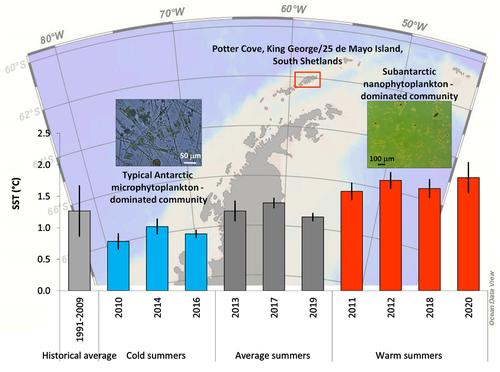当前位置:
X-MOL 学术
›
Glob. Change Biol.
›
论文详情
Our official English website, www.x-mol.net, welcomes your feedback! (Note: you will need to create a separate account there.)
Long‐term studies on West Antarctic Peninsula phytoplankton blooms suggest range shifts between temperate and polar species
Global Change Biology ( IF 11.6 ) Pub Date : 2024-03-18 , DOI: 10.1111/gcb.17238 Julieta S. Antoni 1, 2 , Gastón O. Almandoz 1, 2 , Jesica Goldsmit 3, 4, 5 , Maximiliano D. Garcia 2, 6 , Ximena Flores‐Melo 7 , Marcelo P. Hernando 2, 8 , Irene R. Schloss 7, 9, 10
Global Change Biology ( IF 11.6 ) Pub Date : 2024-03-18 , DOI: 10.1111/gcb.17238 Julieta S. Antoni 1, 2 , Gastón O. Almandoz 1, 2 , Jesica Goldsmit 3, 4, 5 , Maximiliano D. Garcia 2, 6 , Ximena Flores‐Melo 7 , Marcelo P. Hernando 2, 8 , Irene R. Schloss 7, 9, 10
Affiliation

|
The Western Antarctic Peninsula (WAP) experiences one of the highest rates of sea surface warming globally, leading to potential changes in biological communities. Long‐term phytoplankton monitoring in Potter Cove (PC, King George Island, South Shetlands) from the 1990s to 2009 revealed consistently low biomass values, and sporadic blooms dominated by cold‐water microplankton diatoms. However, a significant change occurred between 2010 and 2020, marked by a notable increase in intense phytoplankton blooms in the region. During this period, the presence of a nanoplankton diatom, Shionodiscus gaarderae, was documented for the first time. In some instances, this species even dominated the blooms. S. gaarderae is recognized for producing blooms in temperate waters in both hemispheres. However, its blooming in the northern Southern Ocean may suggest either a recent introduction or a range shift associated with rising temperatures in the WAP, a phenomenon previously observed in experimental studies. The presence of S. gaarderae could be viewed as a warning sign of significant changes already underway in the northern WAP plankton communities. This includes the potential replacement of microplankton diatoms by smaller nanoplankton species. This study, based on observations along the past decade, and compared to the previous 20 years, could have far‐reaching implications for the structure of the Antarctic food web.
中文翻译:

对西南极半岛浮游植物大量繁殖的长期研究表明温带和极地物种之间的范围发生变化
南极西部半岛(WAP)是全球海面变暖速度最快的地区之一,导致生物群落发生潜在变化。从 1990 年代到 2009 年,波特湾(PC、乔治王岛、南设得兰群岛)的长期浮游植物监测显示,生物量值持续较低,且以冷水微型浮游生物硅藻为主的零星水华。然而,2010 年至 2020 年间发生了重大变化,该地区浮游植物大量繁殖的现象显着增加。在此期间,存在纳米浮游生物硅藻,盐盘藻 gaarderae, 首次被记录。在某些情况下,这个物种甚至主导了花朵。盖氏链球菌 因在两个半球的温带水域产生花朵而闻名。然而,它在南大洋北部的盛行可能表明它是最近才引入的,或者是与 WAP 温度升高相关的范围变化,这是之前在实验研究中观察到的一种现象。的存在盖氏链球菌 可以被视为北部 WAP 浮游生物群落已经发生重大变化的警告信号。这包括小型浮游生物硅藻可能被较小的纳米浮游生物物种取代。这项研究基于过去十年的观察,并与过去 20 年进行比较,可能对南极食物网的结构产生深远的影响。
更新日期:2024-03-18
中文翻译:

对西南极半岛浮游植物大量繁殖的长期研究表明温带和极地物种之间的范围发生变化
南极西部半岛(WAP)是全球海面变暖速度最快的地区之一,导致生物群落发生潜在变化。从 1990 年代到 2009 年,波特湾(PC、乔治王岛、南设得兰群岛)的长期浮游植物监测显示,生物量值持续较低,且以冷水微型浮游生物硅藻为主的零星水华。然而,2010 年至 2020 年间发生了重大变化,该地区浮游植物大量繁殖的现象显着增加。在此期间,存在纳米浮游生物硅藻,



























 京公网安备 11010802027423号
京公网安备 11010802027423号